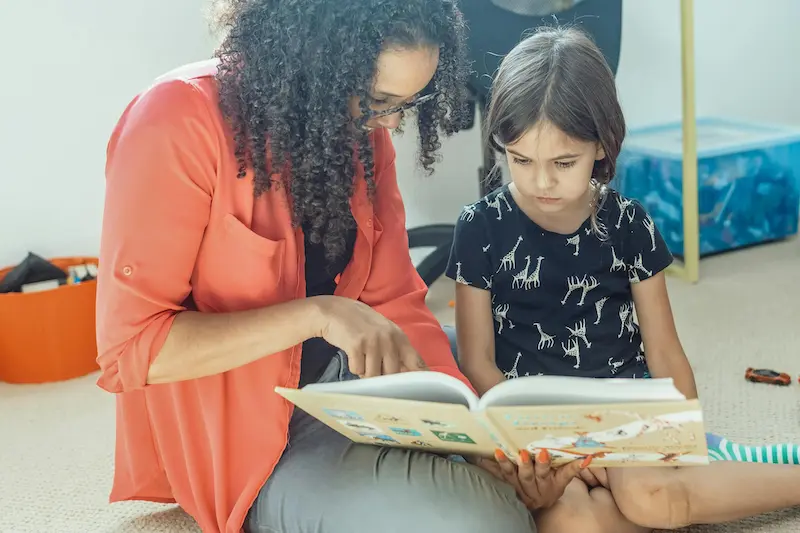settings
children
With Famly since
Sharing high quality picture books is so important, as they provide what children’s literature scholar Rudine Sims Bishop influentially described as ‘mirrors, windows and sliding doors’. Picture books can reflect children’s experiences, providing a space for processing and talking about their lives, or acting as windows into worlds similar or dissimilar to our own. The best books act as sliding doors, opening into the world of imagination.
If you have children in your care facing challenge and uncertainty, early years educators can benefit from a specially selected picture book library.
Stories for sad times: reflecting on loss and difficulties at home
Mediated by a supportive adult, quality picture books can create collaborative spaces for children to work through and reflect upon the emotions generated by these experiences in a focused, supported way.
- ‘Goodbye Mog’ by Judith Kerr sees the death of a beloved cat handled in a hopeful and sensitive way, focusing on the necessary cycles of change tied up in death and birth.
- ‘The Heart and the Bottle’ by Oliver Jeffers helps us think about self-expression when struggling with feelings of grief, loss and loneliness. It celebrates, too, the importance of sharing happy memories in a joyful way as a means of working through these feelings.
- ‘The Sad Book’ by Michael Rosen, illustrated by Quentin Blake, is a very emotionally honest book which articulates the grief and sadness experienced by Rosen upon losing his son. It speaks to children in a refreshingly frank way about coping directly with difficult experiences, and learning to manage our emotions over time.
- ‘It’s a No-Money Day’ by Kate Milner speaks to many children’s experiences of growing up in difficult economic circumstances. It celebrates, too, the strength of children and families who can flourish despite these difficulties, and find love and joy in what they do have.
- ‘The Last Chip’ by Duncan Beedie tells the story of a lonely, hungry pigeon, and illustrates the importance of kindness and sharing against the loneliness and shame which can often accompany poverty. It’s a recommended read I discovered via the fantastic resources of Empathy Lab, an organisation which provides reading lists and advice on using picture books for reflecting upon and developing empathy in young readers.
The big ideas
Writing your own picture book
Perhaps looking through some of the resources available could inspire you as a practitioner to put together your own picture book which speaks specifically to the children in your setting.
Here are some links that will give you some top tips for book-making with toddlers and young children, which show the rich cross-curricular learning which goes into such a project:
- NAEYC: Eight Tips for Creating Homemade Books
- Scholastic: Creating Books With Preschool Students
- PreKinders: Bookmaking in Pre-K
A few more tips of my own would be to use a hole punch as the ‘middle’ of your book (which can start with just one sheet of A3 paper folded in half!). Plus, secure your book with treasury tags. That way, you can add new pages to record children’s responses to using the shared picture book, inserting new ideas, drawings, or photographs when they’re produced.Do make your shared books accessible in your reading corner, where they might attract young readers normally less inclined to interact with stories independently. The promise of contributing artwork of their own can be a powerful catalyst in helping children feel reflected, and more conscious of their role as active participants, in the reading experience.

Picture books to build empathy
Empathy Lab’s book lists are a good resource for reflecting on other social crises we’ve witnessed this summer, too, exemplified by the Black Lives Matter movement. Diversity, representation, and the promotion of empathy, tolerance and respect matter in children’s culture as much as they do in Hollywood and in music, and a high quality picture book library must be reflective of and celebrate the diverse world in which we live.
In response to the ‘Reflecting Realities’ survey conducted by the Centre for Literacy in Primary Education in 2018, which found that only 4% of UK children’s books featured a non-white hero, the CLPE teamed up with Letterbox Library to promote picturebooks celebrating equality and diversity. Their early years picks below are a great place to start in developing your picture book library:

Andy’s picks of the books
My own favourite picture book for reflecting on the social movements we’ve witnessed is ‘Hands Up!’ by Breanna J. McDaniel, illustrated by Shane W. Evans. It tells the story of a young Black girl who lives joyfully and freely, and channels her youthful creativity and optimism in celebration of her, and her peers’, lived experience.
Children, of course, are enormously sensitive to the emotions and experiences of their adult caregivers, who might struggle to see themselves reflected in the joyful, hopeful picture books we share with little ones.
For parents and practitioners, I recommend Charlie Mackesy’s ‘The Boy, the Mole, the Fox and the Horse.’ It’s a ‘grown-up’ picture book which might provide you with a little extra space for reflection and drawing strength during these difficult times. Described as an ‘inspiration and hope in uncertain times’ when it won the (adult!) Waterstones Book of the Year in 2019, Mackesy’s beautifully illustrated book with its spare, profound prose is a testament to the absorptive power of picture books.
Books have the capacity to provide readers of all ages with a mirror, a window, or a sliding door, whenever we need one most.
Andy McCormack is an Early Years teacher, and a PhD candidate at the Centre for Research in Children’s Literature at the Faculty of Education, University of Cambridge.
Get 1000s of free EY activities
Want over 7,000 activities? See them in a free 14-day trial. Filter to target learning areas, age groups and topics, and get inspired.
Get started









